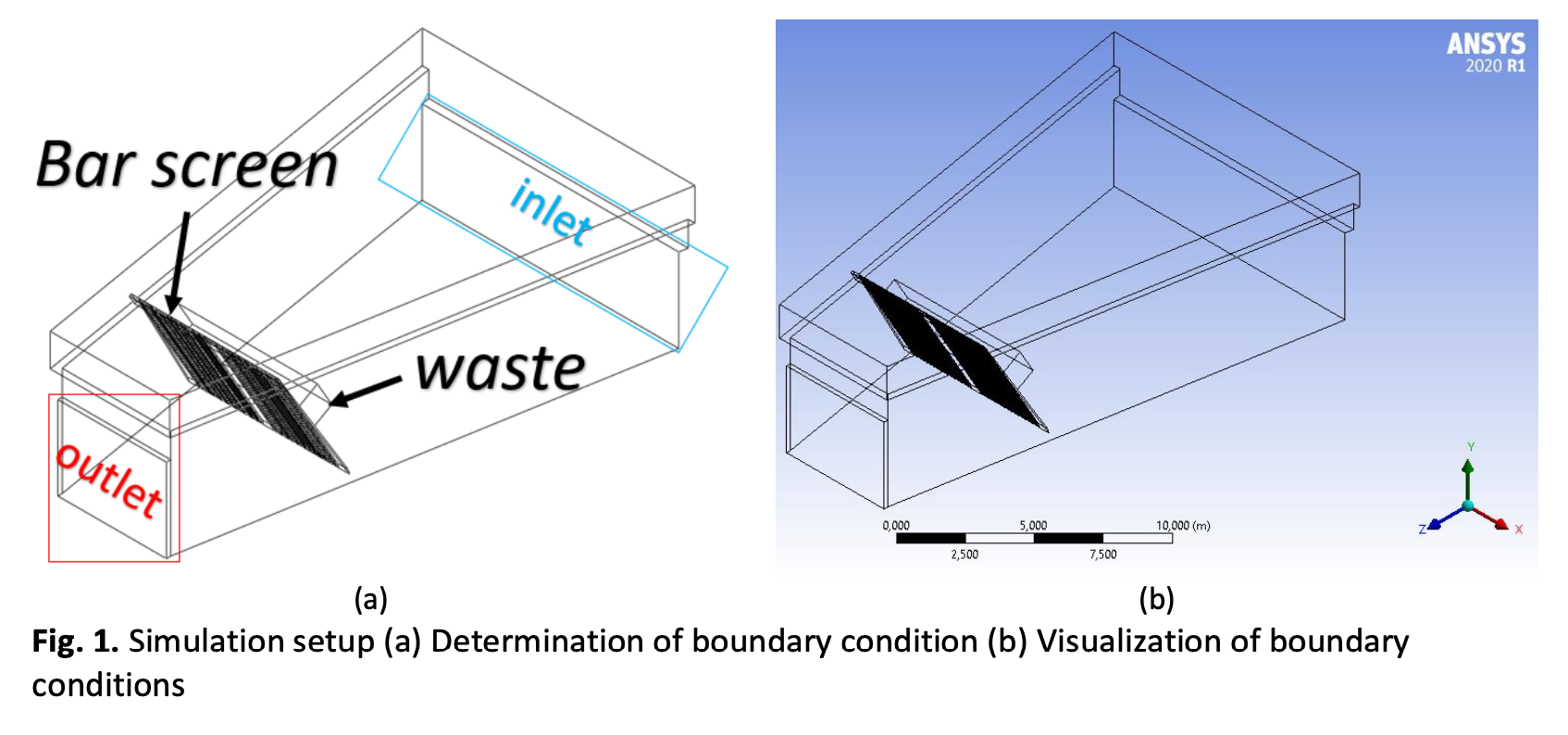Investigation of Effect Garbage Level in Filtration System to Headloss and Water Discharge by Computational Method
DOI:
https://doi.org/10.37934/cfdl.14.12.99110Keywords:
Heat exchanger, intake mouth, filtration system, simulationAbstract
Floating garbage in a filtration system is one of the main factors causing many problems in engineering structures because the accumulation of garbage can block the flow rate. The bar screen installed in a water channel is used to catch the garbage, but the main threat when installing a bar screen in a water channel (intakes) is that system can lead to headloss and disturb (block) fluid flow occurrence. However, there is no concern about the effect of garbage level on the bar screen to head losses and water discharge; for the filtration system, the main concern is discharge. Therefore, this study aims to investigate the effect of garbage level on bar screens to head losses and water discharge by the computational fluid dynamics (CFD) method. Based on the results, the CFD method is capable of predicting the headloss and discharge for the filtration system in the channel. However, the headloss that occurred was insignificant (as still normal) and can reduce the water discharge from the inlet by more than 45%. Then, water energy dissipation due to the narrowing of the flow field consequence of the blockade of garbage. Then, estimating discharge in a filtration system connected to the high seas requires tidal analysis because tides affect the headloss and the water discharge. Further, the headloss is directly proportional to the flow speed and the channel's width.
Downloads
References
Parola, Arthur C., Colin James Apelt, and Mark A. Jempson. Debris forces on highway bridges. No. 445. Transportation Research Board, 2000.
Parola, Arthur C. Highway infrastructure damage caused by the 1993 upper Mississippi River basin flooding. Vol. 417. Transportation Research Board, 1998.
Watterstein, N., Colin R. Thorne, and Steven R. Abt. "Debris control at hydraulic structures in selected areas of the United States and Europe." (1997). https://doi.org/10.21236/ADA344144
Saunders, Selden, and M. Leonard Oppenheimer. "A method of managing floating debris." In Hydraulic Engineering, pp. 1373-1378. ASCE, 1993.
Pitt, Michael. "Learning lessons from the 2007 floods." (2008). [Online]. Available: http://www.ice.org.uk/downloads/2008_flooding.pdf.
Matthew. Graham and Great Britain., "Trash and security screen guide 2009." Environment Agency, (2009).
Fhwa, "Debris Control Structures Evaluation and Countermeasures Third Edition." 2005. [Online]. Available: http://www.fedworld.gov/ntis/.
Tyler, Ryan N. "River debris: Causes, impacts, and mitigation techniques." Alaska Center for Energy and Power (2011): 1-33.
Blanc, Janice. "An analysis of the impact of trash screen design on debris related blockage at culvert inlets." PhD diss., Heriot-Watt University, (2013).
Ibrahim, Hosam, Emam A. Osman, T. A. El-Samman, and Mahmoud Zayed. "Aquatic weed management upstream new Naga Hammady barrages." In Eighteenth International Water Technology Conference, IWTC18, Sharm El-Sheikh, Egypt. 2015.
County, Knox. "Knox County Tennessee stormwater management manual." Compiled by AMEC Earth & Environmental Inc, Knoxville (2008).
Kirschmer, "Otto. Untersuchungen über den Gefällsverlust an Rechen." HYDRAULISCHES Institut, TH MUENCHEN, (1925). https://doi.org/10.1515/9783486752953-003
Fellenius, W., and E. G. W. Lindquist. "Experiments on the head loss caused by protecting racks at water-power plants." Hydraulic laboratory practice (1929): 533-538.
Spangler, J. "Investigation of the loss through trash racks inclined obliquely to the stream flow." Hydraulic Laboratory Practice; ASME: New York, NY, USA (1929): 461-470.
Orsborn, John F. "Rectangular-bar trashrack and baffle headlosses." Journal of the Power Division 94, no. 2 (1968): 111-123. https://doi.org/10.1061/JPWEAM.0000581
Mosonyi, E., Band I. Wasserkraftwerke, and V. D. I. Niederdruckanlagen. "Verlag." (1966).
Zimmermann, Joachim. "Widerstand schräg angeströmter Rechengitter." Inst. für Wasserbau und Kulturtechnik, Versuchsanst. für Wasserbau" Theodor-Rehbock-Laboratorium", (1969).
Wu, Baosheng, and Albert Molinas. "Energy losses and threshold conditions for choking in channel contractions." Journal of Hydraulic Research 43, no. 2 (2005): 139-148. https://doi.org/10.1080/00221686.2005.9641230
Tsikata, Jonathan Mawuli, Chris Katopodis, and Mark Francis Tachie. "Experimental study of turbulent flow near model trashracks." Journal of Hydraulic Research 47, no. 2 (2009): 275-280. https://doi.org/10.3826/jhr.2009.3381
Fluent, A. N. S. Y. S. "Release 15.0, theory guide." ANSYS Inc, Canonsburg (2013).
Roache, Patrick J. "Verification and validation in computational science and engineering." Vol. 895. Albuquerque, NM: Hermosa, (1998).
Babuska, Ivo, and J. Tinsley Oden. "Verification and validation in computational engineering and science: basic concepts." Computer methods in applied mechanics and engineering 193, no. 36-38 (2004): 4057-4066. https://doi.org/10.1016/j.cma.2004.03.002
Prakoso, Aji Putro, Warjito Warjito, Ahmad Indra Siswantara, Budiarso Budiarso, and Dendy Adanta. "Comparison Between 6-DOF UDF and Moving Mesh Approaches in CFD Methods for Predicting Cross-Flow PicoHydro Turbine Performance." CFD Letters 11, no. 6 (2019): 86-96.
Zayed, Mahmoud, Anas El Molla, and Mohammed Sallah. "An experimental study on angled trash screen in open channels." Alexandria engineering journal 57, no. 4 (2018): 3067-3074. https://doi.org/10.1016/j.aej.2018.05.005
Zayed, Mahmoud, and Elzahry Farouk. "Effect of blocked trash rack on open channel infrastructure." Water Practice and Technology 16, no. 1 (2021): 247-262. https://doi.org/10.2166/wpt.2020.110




























